Donald M. Wilson
~ the point that must
be reached ~
(1932
- 1970)
©
Scott N. Currie, UC Riverside, 2011

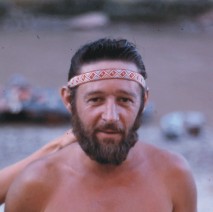
Don Wilson was
a pivotal figure in the emergence of neuroethology as a discipline,
and in the use of invertebrate “simple systems” for neuro-behavioral
research in the 1960s. He remains especially well known for his first locust
flight paper (Wilson, 1961a) that conclusively demonstrated the existence of a
flight "central pattern generator" (CPG) – a central neural network that could produce rhythmic, patterned
motor activity on its own, even when deprived of all movement-related sensory
feedback. His
studies laid the groundwork for later cellular and synaptic analyses of the
flight circuit by Malcolm Burrows (e.g., 1975), Robertson and Pearson (e.g.,
1985) and others that produced a finely detailed understanding of locust flight's
intricate neural mechanism. Wilson pioneered this work as a
postdoctoral fellow in Denmark and continued it as faculty at Yale, U.C. Berkeley and
Stanford. But before all this, while he was still a student, Wilson was also a highly accomplished rock climber.
He
is remembered in that community for numerous first ascents in the American
southwest, including Tahquitz in southern California and several sandstone
towers in the "Four Corners" region of the Colorado plateau. He
died in June 1970 during a whitewater rafting accident in Idaho at the age of
37. W.
Jackson Davis has a hand-written note from Don Wilson, framed on the wall of his
home-office. It’s a Kafka aphorism
(from: The Zurau Aphorisms, #5) that was found on Wilson’s
desk at Stanford shortly after his death was announced. It reads:
“From a certain point onward there is no
longer any turning back. That is the point that must be reached.”
[Earlier versions of this brief biography were presented
in the March
2011 issue of Neuroethology Newsletter and in a history
poster at the 2010 Society for Neuroscience conference.]
Early
scientific
training
Donald
Melvin Wilson was born in Seattle on October 6, 1932 and spent all of his early
life in southern California, graduating from John C.
Fremont high school in south Los Angeles in 1950,
receiving his BS and MS degrees in biology from USC in 1954 and 1956,
respectively, and his Ph.D. in zoology from Theodore
Bullock’s laboratory at UCLA in 1959. (All dates provided by Nancy Wilson;
birth date confirmed from Don Wilson's draft card. The 1933 birth date
originally cited in Wilson's
Stanford obituary was incorrect.) His doctoral thesis was entitled “Nervous control of muscle in Annelids
and Cephalopods” and helped to establish his reputation as a promising young
comparative neurobiologist when it was published as back-to-back papers in the
Journal of Experimental Biology (Wilson, 1960a,
b). This research focused on motor
control in two groups of annelids (polychaetes and leeches) and two of
cephalopods (octopi and squid), and included observations on the muscular
effects of giant axon stimulation in polychaetes (Neanthes brandti and N. virens
Sars) and squid (Loligo pealeii and L.
opalescens
Berry).
The work was conducted at UCLA during the academic year, and at the
Marine Biological Lab in Woods Hole (L.
pealeii experiments) and the Friday Harbor Marine Lab (N.
brandti) during the summers of 1957 and 1958, respectively.
Wilson
extended
that interest in giant axon function in two additional papers that were not part
of his thesis. These included (1)
one of the earliest studies to correlate Mauthner cell activity with fish
startle behavior (Wilson, 1959; using the African lungfish, Protopterus
because of the huge size of its Mauthner axons) and (2) an account of the
electrical connections between lateral giant fibers in the earthworm (Wilson,
1961b). On all four of these papers,
Wilson
was sole
author, which speaks to his drive and self-direction, but also recalls Ted
Bullock’s unselfish encouragement of independence in all his students.
Central
pattern generation in the control of locust flight
After
finishing his Ph.D., Wilson
moved to Torkel
Weis-Fogh’s lab in Copenhagen
for
post-doctoral work (Sept. 1959 - Oct. 60), where he began his locust flight
experiments. He used an ingenious
setup (see below) which permitted the
synchronization of wing muscle or nerve recordings with stroboscopic
photographic records of wing position during flight.
The insects flew in-place, suspended at the end of a pendulum in front of
a wind-tunnel. The other end of the
pendulum acted as the arm of a double-throw switch that controlled the wind
velocity via a servo-mechanism, so that the strength of the animal’s forward
flight controlled wind speed.
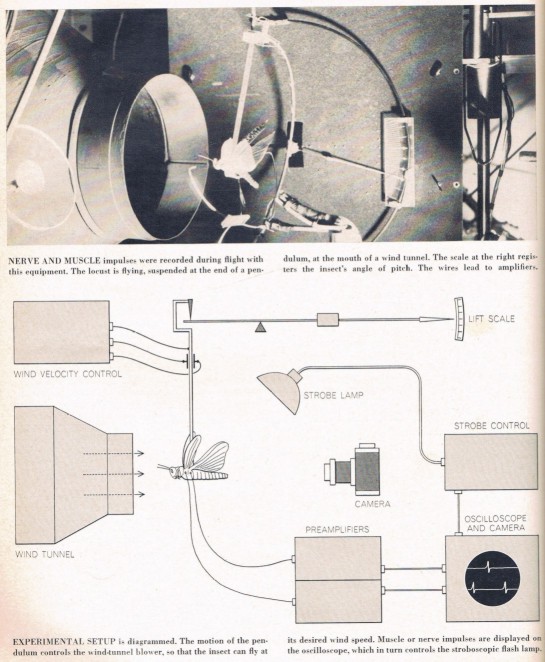
Experimental apparatus used by Wilson (1961a) to record wing position
along with sensory nerve and muscle impulses during tethered locust flight.
Wing muscle action potentials triggered a strobe lamp, which captured
wing position via a camera with an open shutter and permitted synchronization of
wing-position with nerve/muscle activity (from Scientific
American,
Wilson, 1968.)
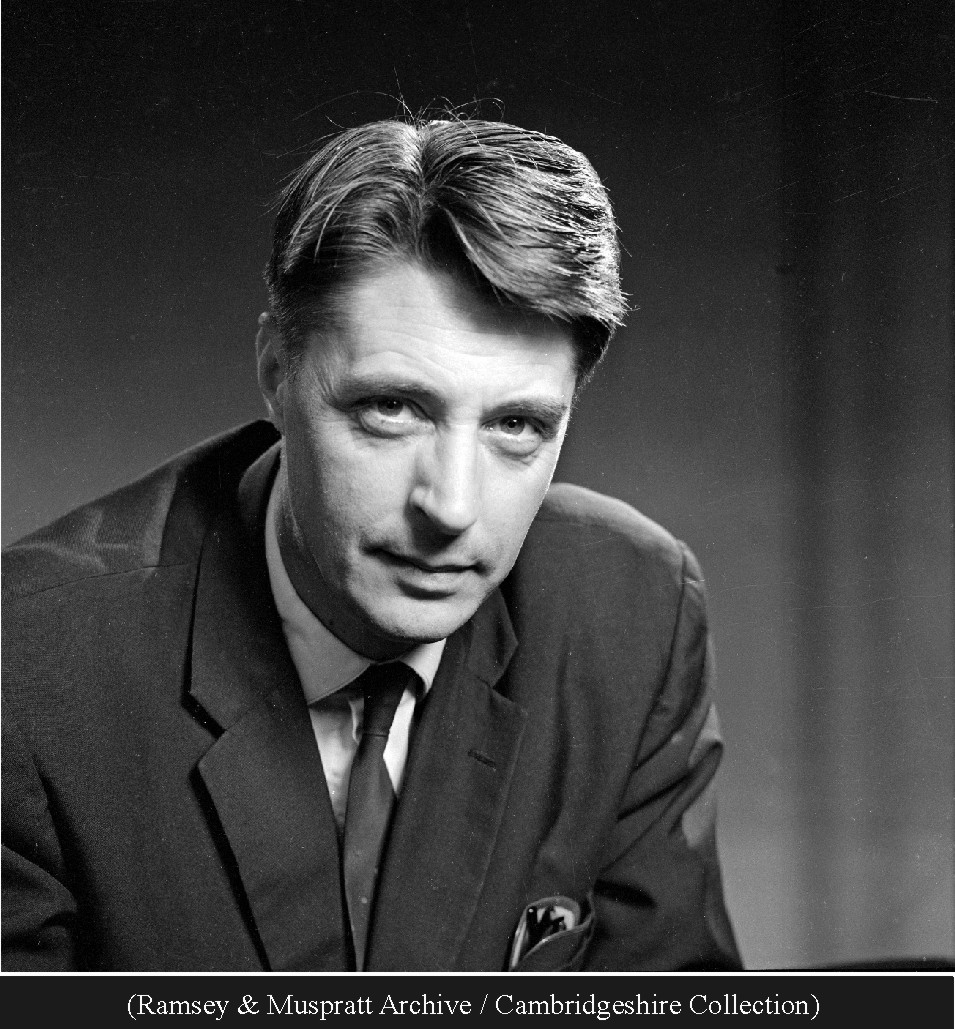
Portrait
of Torkel
Weis-Fogh at Cambridge University, 1969. The original hangs in the Cambridge
University
Zoology (Balfour & Newton)
Library, and is used with their permission (Ramsey & Muspratt / Cambridgeshire Collection).

From:
Wilson and Weis-Fogh(1962)
The
essential result of Wilson’s 1961
JEB paper was that the basic flight motor pattern remained intact following
partial or complete deafferentation of the wings, showing that movement-related
sensory feedback was not necessary for the construction of normal motor
patterns, and indicating the existence of a central pattern generator for
neurogenic flight in the locust. This
was at a time when Sherrington’s “chain-reflex”
hypothesis for motor pattern generation, in which simple sensory reflexes
triggered each other sequentially to form complex motor patterns (Sherrington,
1947; p.182), was still widely favored (Hoyle, 1980; Bullock, 1995; Edwards,
2006; Stuart, 2007; Mulloney and Smarandache, 2010).
After returning from Copenhagen, faculty
appointments followed at Yale (Oct. 1960 – Aug. 61), UC Berkeley (Sept. 1961
– June 68), and Stanford (July 1968 – June 70). The term “central pattern
generator” (actually, “central nervous pattern generator”) was coined in another significant
paper written with one of Wilson’s early
graduate students at UC Berkeley, Robert Wyman (Wilson and Wyman, 1965.) This
article showed that random or rhythmically timed electrical stimulation of the
thoracic nerve cord in decapitated and wing-deafferented locusts still evoked
coordinated motor output that resembled normal flight motor patterns.
Coordinated flight activity began only after many stimuli, exhibited a
wind-up of cycle frequency over multiple seconds until it reached a constant
level (about 20 Hz), then displayed many cycles of after-discharge following
stimulus-offset. All of these
effects are strikingly similar to the non-linear summation of subliminal stimuli
and prolonged motor after-discharge that Sherrington (1947) described for
hindlimb scratch motor patterns in low-spinal dogs – and suggest a similar
build-up and storage of excitation in a central neural network.
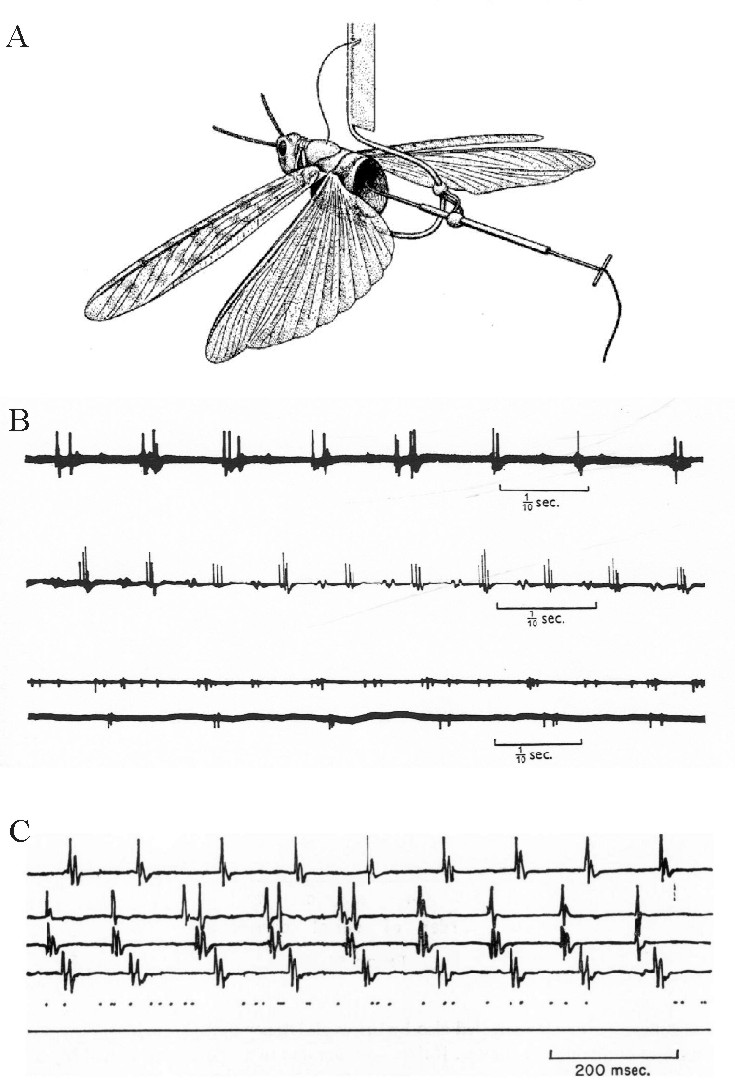
A:
Surgically reduced locust
preparations, with viscera and varying amounts of their body walls removed,
still exhibited wind-induced flight motor patterns, even after movement-related
sensory feedback from the wings was reduced or completely abolished
(Wilson, 1968b)
B: Fictive flight motor patterns recorded from the central stumps of
the metathoracic and mesothoracic nerves in highly reduced locust preparations
in which all sensory feedback from the wings had been eliminated (Wilson,
1961a.)
C: Coordinated flight motor pattern recorded from 4 wing muscles
in a headless preparation in
response to randomly timed electrical stimulation of the ventral nerve
cord,
indicated by dots (Wilson and Wyman, 1965).
Wilson’s relatively brief time at
Berkeley (~6.5 years) also resulted in some of the earliest computational and
analog electronic models of pattern generating neural networks (Wilson, 1966,
Wilson and Waldron, 1968). In addition, there were analyses of neuromuscular control in
myogenic Dipteran flight (Nachtigall and Wilson, 1967), models of interlimb
coordination during 8-legged locomotor
gaits in tarantulas (Wilson, 1967), and elegant studies that assessed the role of
movement-related sensory feedback in modulating centrally driven motor patterns
and compensating for perturbations (Wilson and Gettrup, 1963; Wilson,
1965;
1968a). In one of these papers (Wilson,
1968a), he nicely summarized the complementary roles of the CPG and sensory
feedback in constructing adaptive behavior: "In the
locust flight control system proprioceptive reflexes and exteroceptive inputs
supplement and complement the information built into the CNS. Hence, even though
the ganglia are pre-programmed to produce a nearly normal motor output pattern,
that pattern can be modified to meet current needs. It seems to me that the CNS
has programmed into it through the genetic and developmental processes, nearly
everything that it is possible for it to know before actual flight occurs. The
sensory inputs supply only the genetically unanticipatable information such as
wind direction and position of the horizon." "... Overall
it appears that the flight control system is a very safe one, having a
multiplicity of complementing mechanisms. It is centrally pre-programmed,
perhaps to the fullest extent possible, but it also has a superimposed set of
reflexes which can simultaneously relate the animal to its environment,
compensate for bodily damage, and correct errors in its central programme.
As a result it can tolerate a high degree of damage and still carry out a very
demanding activity."
Rock
Climbing
Wilson
met Frank Hoover and Fred Martin while in high school during a summer intern
program at the LA County Museum of Natural History and the three began
backpacking and climbing together in the Sierra Nevada (Fred Martin, pers.
commun.). He started
rock
climbing more seriously as an undergraduate biology major at USC (Frank Hoover, pers. commun.) and developed in to a world-class climber by
the mid 1950s, when he was in his early twenties.
He is still well known amongst the rock-climbing cognoscenti for a number
of extremely hairy first ascents, with small teams made up of the early hot-dogs
of the sport (Royal Robbins, Jerry Gallwas,
Mark
Powell, Bill “Dolt” Feuerer, Chuck Wilts, Warren Harding).
His records began with several important California climbs in
the early to mid 1950s, including “Open Book” at Tahquitz (Idyllwild, CA;
see
Robbins, 2010: "Fail
Falling") in 1952
and a famous first attempt at the NW face of Half Dome in Yosemite
in 1955
– an attempt that only made it about 1/4 of the way up the sheer wall of rock,
but attracted the interest of the Saturday Evening
Post. During this period, Wilson
also helped devise the YDS (Yosemite Decimal System) with Royal Robbins and
Chuck Wilts, which permitted the precise gauging of difficulty levels for
“free climbs” (without aids) on a 5.0-5.9 scale, and he co-authored the
“Climber’s Guide to Tahquitz Rock” with Wilts in 1956, which detailed the
YDS for the first time. (At the time, Chuck
Wilts was a professor of Electrical Engineering at Caltech and a pioneer in
the fields of electric analog computers and feed-back control systems.) Wilson
remains
best known in climbing circles for his first ascents of several sandstone desert
towers in the “Four
Corners” region
of the southwest. These included “Spider Rock” (March 1956) in Canyon de
Chelly, Arizona, “Cleopatra’s Needle” (Sept. 1956) in
the Valley of Thundering Water,
New Mexico
and the
“Totem Pole” (June 1957) in Monument
Valley, Utah. All these desert spire
climbs occurred during a 15-month period in which
Wilson
finished
his M.S. degree at USC and began full-time work toward his doctorate at UCLA
(Burton, 1956; Wilson, 1957a, 1957b, 1958; Breed, 1958; Sherrick, 1958; Roper,
1970; Jones, 1976; Gallwas, 2007, 2010; Bartlett, 2010). Following the Totem
Pole ascent, the
Desert
Tower
team
(Wilson, Gallwas, Powell, Feuerer) went their separate ways. Don and Nancy
Wilson traveled by VW Bug to Woods Hole, Massachusetts so that Don could spend
the rest of the summer 1957 at the Marine Biological Lab.
After that, he completed his Ph.D. at UCLA with Ted Bullock, then moved
to Copenhagen
to
post-doc with Torkel Weis-Fogh and begin his seminal locust flight studies.
After his return to the United
States
in a
series of faculty positions, he continued to climb for pleasure with friends and
family, but no longer pursued records.

A:
Don Wilson (on left) and Frank Hoover, c.1952-53, when
Wilson
was an undergraduate at USC.
Check
out the climbing footwear.
From an article in
Summit
magazine, August 1956 (Photo by Niles
Werner.).
Original caption: “Off for
a Sunday practice
session of rock climbing are these members of the Angeles Chapter, Sierra Club
Climbing Section. Well-known
for their outstanding ability and agility on the rocks are Don Wilson and Frank
Hoover. Don recently made a “first ascent” of Spider Rock in Canyon de
Chelly National Monument, and Frank is presently Vice Chairman of the Angeles
Chapter Rock Climber.” B: Wilson
(lower right) belaying
Hoover
on Old Woman Rock in Hidden Valley Campground, Joshua Tree
National Park. (From
the Barbara Lilly Collection, Sierra Club Angeles Chapter Archives, photo by
Niles Werner.)
A
list of Wilson’s most significant
climbs (FA = First Ascent; FFA = First Free Ascent):
-
1952
FFA, Open Book (the first 5.9), Tahquitz, Idyllwild, CA
with Royal
Robbins.
-
1952
FA Super Pooper, Tahquitz, with Chuck Wilts, John & Ruth Mendenhall
-
1953
2nd ascent of Sentinel North Face, with Royal Robbins and Jerry Gallwas (2 days)
[See Camp
4, by Steve Roper, pg. 56, and Fail
Falling, by Royal Robbins]
-
6/1955
attempted Half Dome NW Face,
Yosemite
, with
Jerry Gallwas, Royal Robbins, and Warren Harding (reached 450' in 2.5 days).
[See Jerry Gallwas talk
about the attempt on YouTube and his write-up
of the 1955 attempt and the 1957 first ascent.]
-
3/1956
FA Spider Rock, with Mark Powell and Jerry Gallwas
-
6/1956
FA Lower Cathedral Rock East Buttress, with Mark Powell and Jerry Gallwas (14
hours)
-
9/1956 FA Cleopatra’s Needle, with Jerry Gallwas and Mark Powell
-
12/1956
FA Kat Pinnacle NW Corner, with Mark Powell
-
1957
FA, Finger Rock, north face (a.k.a. Bill Williams Memorial, Arizona), with
Mark Powell and Bill Feuerer
-
6/1957
FA Totem Pole (Monument
Valley), with
Mark Powell, Jerry Gallwas and Bill Feuerer

In
the third week of June 1955, Don Wilson, Royal Robbins, Jerry Gallwas and Warren
Harding attempted to climb the NW face of Half Dome in Yosemite, but a
series of problems ended the climb after two and a half days, by which time they
had ascended only about one quarter of the 2000-foot face.
In September 1955, the team was photographed and interviewed for an
article in the Saturday Evening Post (article titled “They risk their lives
for fun”, by Hal Burton,
Feb. 25,
1956
).
These photos were staged for the article, but were not used. A:
Left to right: Royal Robbins, unknown park ranger, Don Wilson (sitting in
driver’s seat), Jerry Gallwas and Warren Harding signing out at
Government
Center
in
Yosemite
National
Park
.
B: Posing on Overhanging
Rock at Glacier Point. Left to
right: Wilson, Harding, Gallwas, Robbins. Note Half Dome in background of both
scenes. (Photos courtesy of Jerry
Gallwas.) C: Left to right: Harding,
Gallwas, Robbins, Wilson. The contrasting body language of Wilson and
Harding has been explained by Jerry
Gallwas (see youtube
video, 3:49) and by Warren Harding (in his book, "Downward
Bound", pg. 107 ; Harding 1975). Robbins and Gallwas
returned to Half Dome with Mike Sherrick during the last week of June 1957 to
make the first complete ascent of the NW Face (Sherrick 1958; Gallwas, 2007).
Don Wilson was conducting research on squid at the MBL in Woods Hole, MA
during the successful 1957 ascent.
It's amazing, if nightmarish, to note that Alex
Honnold has since completed a ropeless free-solo climb (without
any harness or safety equipment) of Half
Dome's NW face in 2 hours, 50 min...
I
include here some brief excerpts from Don Wilson’s own published descriptions
of the three major
Desert
Tower
climbs –
Spider Rock, Cleopatra’s Needle and the Totem Pole.
I especially like his approach to the “legend of Spider Rock” as a
testable hypothesis. Both Spider Rock and
Totem Pole are fairly well-known landmarks. Spider Rock appeared in the
1969 Gregory Peck film "Mackenna's
Gold", although renamed "Shaking Rock" (see movie
clip). The fifth and
final officially permitted ascent of the Totem Pole was in 1975, when two
climbers were hired by Clint Eastwood and Universal Studios to locate a suitable
rock tower and “put the ropes up” for a climbing sequence in the film “The
Eiger Sanction” (Bjørnstad and Wyrick, 1976; Bartlett, 2010).
As part of a deal with the local Navajo council, the climbers removed all
existing hardware from the tower at the end of filming, including the can
(placed on the summit in 1957) containing the original summit-register of
Wilson, Powell, Gallwas and Feuerer. The register now resides in the collection
of the
Bradford
Washburn
American
Mountaineering
Museum,
Boulder,
Colorado
(Gallwas,
2010).
The
First Ascent of Spider Rock
[Don Wilson (1957) Sierra Club Bulletin 42(6): 45-49]:
“In Canyon de
Chelly
National
Monument
in northeastern
Arizona
is a great sandstone spire. According to the Navajos, who call it Spider Rock,
its summit is the home of the Spider Lady. Navajo
children are told that Speaking Rock across the valley informs the Spider Lady
of their misdeeds and that she will take them to her home and devour them. The
bleached rubble on the summit is supposed to be the bones of bad children.
Since the truth of this last statement is testable, it was possible to
disprove the legend of Spider Rock by examining the rubble at close range.
Of the three tried means of reaching a summit two were impossible here.
It was too small for an air-drop and too far away to throw a rope over.
It could be reached only by classical mountaineering methods in a
long-climb from the valley floor.”
[Spending
the night bivouacked on a ledge.] “…After
some canned sausages and gumdrops, we put all our clothing on, and tried to
sleep as much as possible, not so much for rest as for shortening the period of
consciousness of the cold. But as
large as our ledge was, it was not smooth and a comfortable position was not
possible. We were tied in, of
course, to prevent rolling off, and it was this fact that later became
dramatized in the newspapers to “they spent the night lashed to the cliff.”
We watched the sunrise and then waited for the sun to hit us before
breakfasting. It was only 200 more
feet now.”
[On
the summit.] “…During
the hour we spent on top we built
cairns
,
piling the “bones” into two
little monuments – not worried about our
disturbing an old legend. For some
time we enjoyed watching the spectators on the rim watching us.
Meanwhile Aubuchon [the
park Superintendant] drove to Chinle,
telegraphed our families, and informed the newspapers.
Spider Rock had been climbed.”
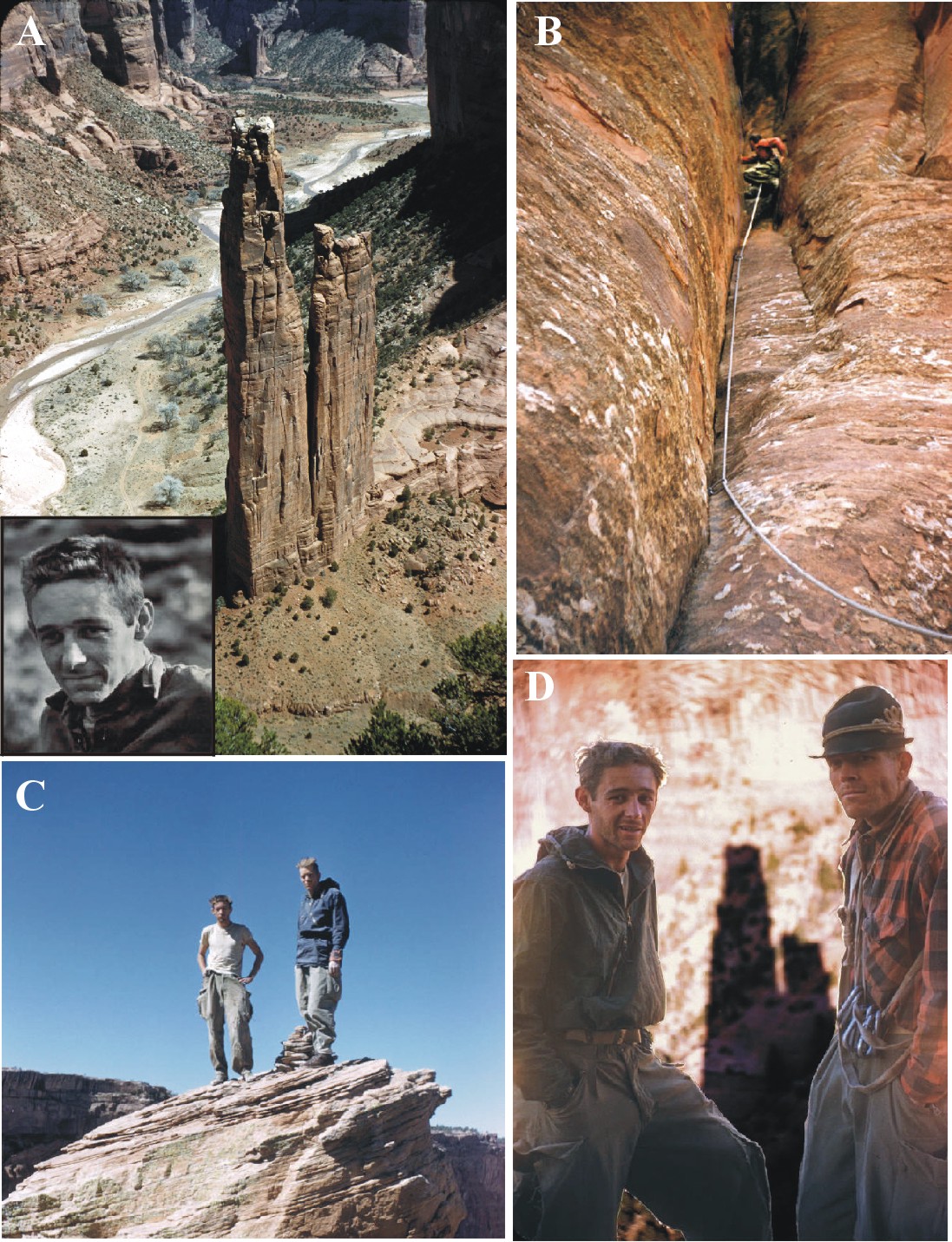
Spider
Rock, in Canyon de
Chelly,
AZ,
is the tallest free-standing spire in the world (832 feet from the bottomland to
the summit; approx. 2/3 the height of the
Empire
State
Building).
First
ascent made by Don Wilson, Mark Powell & Jerry Gallwas in March 1956. Wilson
was finishing his MS degree in biology at USC at the time.
A: Spider Rock, photographed
from the Overlook by Jerry Gallwas during a 1955 reconnaissance trip.
Inset: Donald
Wilson, c.1956-57 (Ascent Collection, courtesy of Steve Roper.)
B:
Wilson
ascending the “chimney” between the two spires.
C and D: Wilson and Powell on the summit (Wilson
on left. Note the shadow of Spider Rock in D).
(All photos except inset in A courtesy of Jerry Gallwas.
Gallwas, 2010)
Cleopatra’s
Needle
[Don
Wilson (1957) Sierra Club Bulletin 42(6): 63-64]: “For
several years we had known about a spectacular spire in
New
Mexico
through pictures advertising a bus company.
As we became familiar with sandstone climbing, we began to inquire where
that spire was, how high, how fractured and how soft the sandstone.
We found an article stating that the needle (they called it Spider Rock,
possibly confusing it with the one in Canyon de Chelly) was 265 feet high and
was in the
Valley
of
Thundering
Water
near
Fort
Defiance
,
Arizona
.
Mark Powell visited the valley last spring and brought back an excellent
report.”
[Describing
the soft rock and loose pitons.] “…I
unsnapped from my top piton and descended onto the next.
It began to pull out. Quickly
I lowered myself to the next. It
also shifted. The fourth held my
weight but now I could not reach back up to unsnap from the loose ones.
I came down to the ledge knowing that tomorrow’s leader had no pleasant
task.”
[On
the summit.] “...
Meanwhile on the summit, a ridge 10 feet long which we straddled, we became
aware of a new annoyance. All around
us thunder showers were brewing and we sat on a lightning rod over a plain.
But the clouds dissolved and we had the late afternoon sun as we built a
cairn and prepared our rappel anchor.”

Cleopatra's
Needle, in the Valley of Thundering Water, New Mexico. A: The spire
just after the arrival. First
ascent made by Don Wilson, Mark Powell & Jerry Gallwas in September 1956.
B: Another view, showing Wilson climbing up the base shortly after
arrival. Note Don and Nancy Wilson's VW Bug near the base of the spire in
both photos.
(Photos courtesy of Jerry Gallwas.
Gallwas, 2010)
The
Totem Pole
[Don Wilson (1958) Sierra Club Bulletin, vol. 43 (9): 72]:
“Several years of effort came to
an end last June when Bill Feuerer joined Jerry Gallwas, Mark Powell and me to
complete the first ascent of the Totem Pole in Monument Valley.
This effort began with an agreement between the three to try to climb
what they considered to be the three most important of the Southwest’s desert
spires: Spider Rock, Cleopatra’s Needle, and the Totem Pole.
At that time none of the desert’s great sandstone spires had been
attempted. Both of the first two
were climbed on the first try. Spider
Rock was highest, Cleopatra’s Needle the softest and therefore least safe, but
the last turned out to be the most difficult.”
[Making the summit, the day
after placing bolt screws in the rock.] “…The last morning we drove to the base
of the talus in Jerry’s jeep, and a caravan of spectators from the Post
followed after breakfast. On the
prussik lines we were harassed by gusts of wind which swung us 30 or 40 feet
across the rock face. We reached the
summit after about 13 hours of upward progress spread over the several days.
As we descended, a little rain fell, reminding us of the lightning which
had stopped the earlier party.”
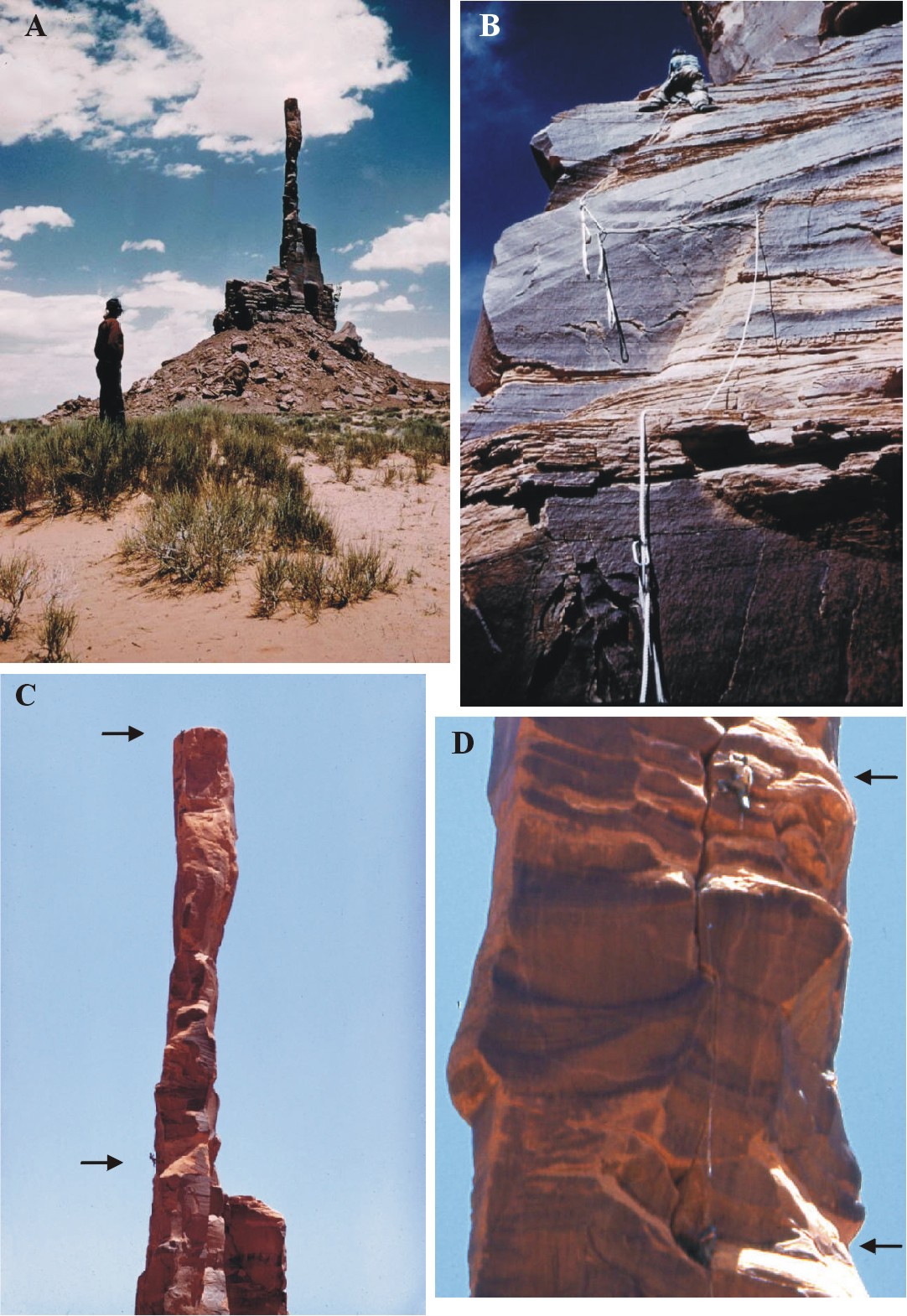
Totem Pole in
Monument
Valley,
Utah
(June 1957).
The first ascent team consisted of Don Wilson, Jerry Gallwas, Mark Powell and
Bill “Dolt” Feuerer. Wilson was
then a Ph.D. student in Theodore Bullock’s lab
at UCLA.
A: From a distance, with Navajo looking on.
B: Don Wilson leading a pitch
on the afternoon of the first day.
C: Gallwas climbing over the
lip of the summit (upper arrow) and
Wilson
“prusiking” (ascending a rope via a prusik line; lower arrow).
D: Powell leading (upper
arrow) with
Wilson
belaying (lower arrow). All photos
taken by Bill Feuerer (from the Dolt Collection, courtesy of Jerry Gallwas and
Don Lauria.)

A:
On the 14 x 25-foot summit
of the Totem Pole, following the first ascent.
Photo taken by Bill Feuerer.
Left to right: Mark Powell, Don Wilson and Jerry Gallwas.
A tour bus is visible on the desert floor (arrow), just above the rock
cairn between Powell and Wilson. B:
Auto-timed shot of all 4 team members on the summit.
Left to right: Powell, Gallwas, Feuerer and Wilson.
Note the puddle in foreground. It had not been raining.
From Jerry Gallwas (pers. commun.): “The
picture of the four of us on top of the Totem Pole was taken with Bill Feuerer's
camera. There were 100 people on the
ground watching and we needed to pee so we gathered in a circle as if to pray
and used the only dimple on top.” (Dolt Collection, courtesy of Jerry Gallwas.)
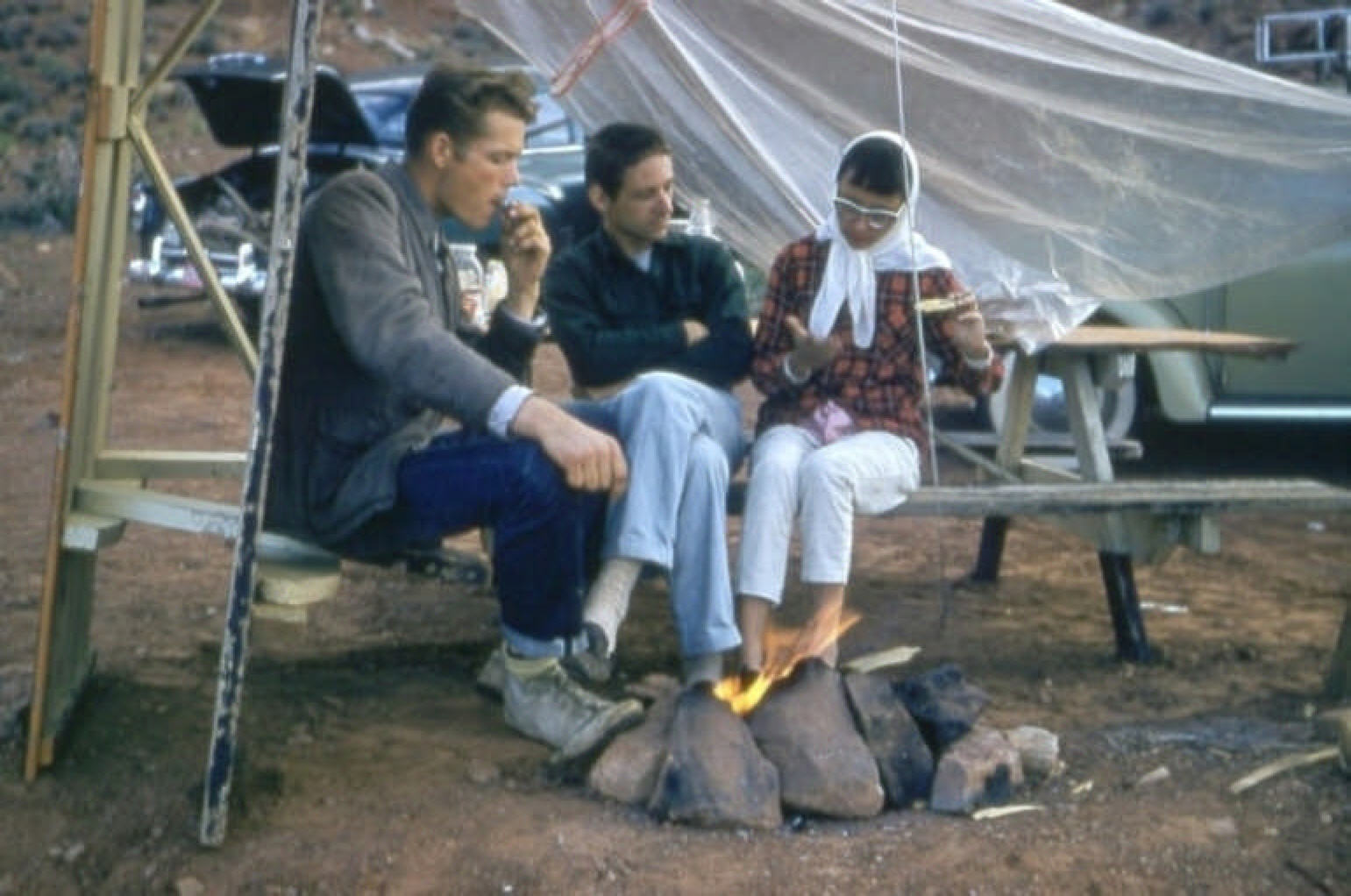
Warming
themselves at a campfire during a rainy day in Monument Valley.
Left to right: Mark Powell,
Don Wilson, Nancy Wilson. June 1957. (Dolt Collection. Courtesy of
Jerry Gallwas.)
Campus
Activism
While
at U.C. Berkeley (1961-68), Wilson
became
involved in the Free Speech Movement, the aim of which was
to give students the right to organize on campus in support of political causes.
He was close friends with its fiery student-leader, Mario
Savio, and a number
of graduate students and undergraduates in the Wilson
lab during
the mid-sixties were likewise active in the movement.
Wilson
named his
laboratory the “Sympathetic Ganglion” (written on a plaque above the door)
to indicate solidarity with the FSM (W.J. Davis, pers. comm.) and kept a
bullhorn in the lab “with which to address student rallies” (Edwards, 2006).
But political engagement on campus did not trump research progress.
Ingrid Waldron recalled that while Wilson was quietly supportive of her
campus political activities for about a year, he then insisted that it was time to get
to work and finish her thesis – prodding her to “finish in a
respectable five years, instead of six”
(I. Waldron, pers. comm.).
In July 1968, Wilson
left U.C.
Berkeley for Stanford, following a disagreement with his Department Chairman
regarding the use of grades to alter military draft status (Mulloney and
Smarandache, 2010, footnote 2). But,
his activism continued at Stanford, where W. Jackson Davis (who was then a
post-doctoral fellow in Don Kennedy’s Stanford lab) remembered being “first
tear-gassed by a helicopter with Don (Wilson)… near
the tower.” (W.J. Davis, pers. comm.).
Rafting
and the fatal accident
In 1959, Wilson and life-long friend Frank Hoover went
rafting together for the first time at Glen Canyon on the Colorado river (Frank
Hoover, pers. commun.). They took to this new adrenaline rush as they had
to rock climbing as teenagers, and by 1970, Wilson, Hoover and their circle of
friends had navigated a long list of the most
challenging white water in the western U.S., including the Rogue river in Oregon (during flood
stage), and the Cataract and Grand Canyon legs of the Colorado (Frank Hoover
and Ken Boche, pers. commun.; Al
Bukowsky's interview with Middle Fork river-guide, Roy
Nicholson, 2012; Couture,
1971). According to most accounts, Wilson's accidental death at the age of 37 occurred on Sunday June 21, 1970 (Couture,
1971; Collins and Nash,
1978), while rafting the Middle Fork of the
Salmon
River
in north
central Idaho.
However, it was reported as June 23 in his obituaries (Hoover,
1970; Kennedy et al.,
1970). The river was extremely flooded and especially turbulent that week from recent
snow melts, running at speeds up to 15-20 miles per hour with waves as high as
10-20 feet (Couture, 1971;
Collins and Nash, 1978; Al
Bukowsky, pers. commun.). Wilson
led a
party of nineteen people that included Frank Hoover in four of Hoover’s
WWII-era 10-man
rafts (Hoover, pers. commun.; Collins and Nash, 1978).
Wilson
was at the
oars of his raft, which had a broken oar-lock. Only 15-20 minutes
after
launching near Dagger Falls, they were entering Velvet Falls about 4 miles
down-river (below the mouth of
Sulphur
Creek, where it meets the Middle Fork; see map
1, map
2), when a member of Wilson's party was ejected from the back of the raft and carried by the water into some
brush at the river bank (from Al
Bukowsky's interview with Roy
Nicholson, 2012; see also recent rafting
and kayaking videos of
Velvet Falls.) Seeing this, Wilson
ran his
raft aground on "an island" or shallow embankment near the opposite
shore (Hoover,
1970;
Frank Hoover, pers. commun.) and
attempted to swim across the river to rescue the crew member with his raft's
bow-line tied
around his waist, secured on its other end to the raft.
This was a lethal mistake that might have resulted from Wilson's rock-climbing
habits and the panic of the moment. When he entered the river, the powerful current immediately swept him off
his feet and pulled him down-stream and under water, taut at the end of the rope.
By the time he was pulled back in, he had already drowned. The
ejected crew member had made it to shore and was unharmed.
Amongst the devastated
survivors, some decided to hike back to the
Dagger
launch site, while
others continued down river with Wilson’s body
for another 26 miles to over-night near the Indian Creek
Airstrip.
A light aircraft arrived the next day to pick the group up, and Wilson’s ashes
were later spread on the Middle Fork (Frank Hoover, pers. commun.; Hoover, 1970;
Collins and Nash, 1978; Robbins, 2009). He
was survived by his ex-wife, Nancy, and four children.
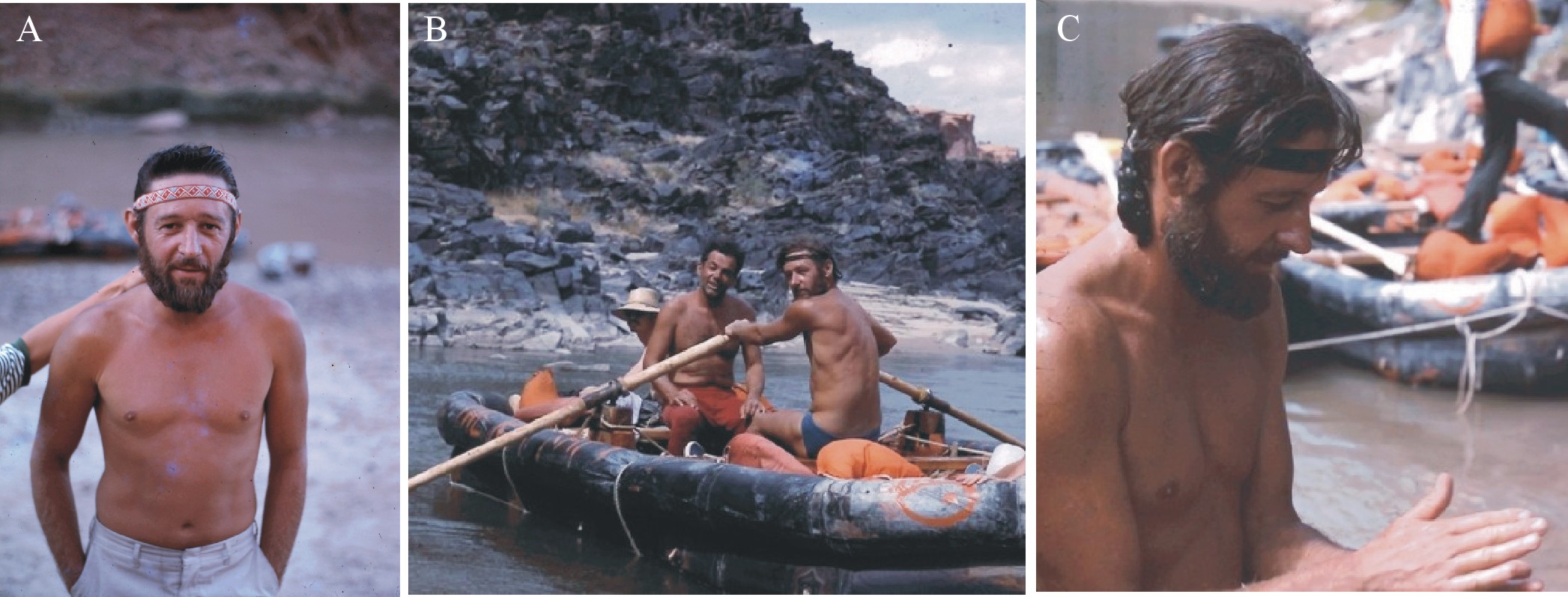
Donald Wilson in 1969, during a rafting trip on the
Colorado
river
.
A:
Cataract
Canyon,
Glen
Canyon
National Recreational Area, Utah.
B:
Wilson
holding the oars,
Westwater
Canyon,
Colorado.
C: With a captured spadefoot toad.
(Photos courtesy of Ken
Boche).
Wilson’s
fatal rafting trip on the Middle Fork of the
Salmon
River
in Idaho
occurred about one year later at “Velvet
Falls”
(see map),
so named because the rapids make little or no sound until you are upon them
(Collins and Nash, 1978).
That same Sunday
afternoon of June 21, two other groups launched from Dagger Falls ahead of the
Wilson party. Tom Brokaw (the future NBC News anchor) was with a group led by river-guide Everett Spaulding (Brokaw, 1970; Collins and Nash, 1978).
The other party was led by Al Couture (Couture,
1971). Both groups struggled, but made it safely through Velvet Falls
and continued down-river until Thursday June 25.
Neither party learned of Wilson's accident until later. On Thursday, Brokaw’s close friend Ellis Harmon and Spaulding's associate Gene
Teague were both swept away and
killed at Weber
Rapid (downstream from the site of Wilson’s
accident, referred to by Brokaw as “Webber
Falls”) when
their McKenzie boat was swamped and sank in the white-water. Brokaw
wrote about it a few months later in an article titled “That river swallows
people. Some it gives up. Some it don’t.” (Brokaw, 1970; the title coming
from a Spaulding quote). In the following
excerpt from Brokaw's article, he mentioned the fate of a “Stanford
professor” (Wilson):
“That week the Middle Fork and
the main Salmon swallowed six people. On
the main Salmon two
U.S.
Forest
Service employees drowned when their pickup truck was forced off the road into
the river, and a
Detroit
teenager was swept away when his kayak capsized.
A Stanford professor drowned in the Middle Fork when he attempted to
cross the river while attached to a rope. At
the time we were unaware of the deaths. When
word of our accident spread, two parties behind us which included Sir Edmund
Hillary, the conqueror of Mt. Everest, and Frank Gifford, the sportscaster and
former football star, got out of the river at the Flying B Ranch.”
The Couture party was the only one of the three groups that launched on
Sunday to make it through the trip without a fatality. In the Outdoor Life
article that Al Couture published several months later (Couture,
1971), he described seeing one of the bodies from the Spaulding group float by in a life preserver
near the Cradle Creek campground while he and his party were pulling their boats
in to a quiet backwater. Gene Teague was
never found.
The Middle Fork has more than forty sets of rapids, but when flooded by
spring snow-melts, it becomes essentially one continuous rapid along its whole
length, from Dagger
Falls
to the
confluence with the greater Salmon
River.
A few summers later (June 1974), the U.S. Forest Service warned that any
attempt to run the flooded Middle Fork was “suicidal” (Collins and Nash,
1978). The third week of June 1970
was the deadliest in the river’s modern history, and remains infamous amongst
Middle Fork rafting guides (Al Bukowsky,
pers. commun.).
References
Neuroethology
Bullock,
T.H. (1995)
Neural integration at the mesoscopic level: the advent of some ideas in
the last half century. J. Hist. Neurosci. 4 (3-4): 216-235.
Burrows,
M. (1975) Monosynaptic connexions between wing stretch receptors and
flight motoneurones of the locust. J. Exp. Biol. 62: 189-219.
Currie, S.N.
(2010) The short intense life
of Don Wilson: Neuroethology pioneer, elite rock climber, activist and
adventurer. Soc. Neur. Abstr. vol. 36.
(See http://faculty.ucr.edu/~currie/wilson.pdf)
Currie,
S.N. (2011) Donald M. Wilson (1932-1970): "The point that must
be reached." Neuroethology Newsletter (March issue). https://www.neuroethology.org/Portals/2/Mar_11.pdf
Edwards,
J.S. (2006) The central nervous control of insect
flight. J.
Exp. Biol. 209: 4411-4413.
Hoyle,
G. (1980)
Neural mechanisms. In: Insect
Biology in the Future. Academic
Press, N.Y., pp. 635-665.
Kennedy,
D., Davidson, J.M. and Hanawalt, P.C. (1970)
Memorial resolution: Donald M. Wilson (1933 –
1970). Stanford
Historical Society, Faculty Memorials. http://histsoc.stanford.edu.
Mulloney,
B. and Smarandache, C. (2010) Fifty years of
CPGs: two neuroethological papers
that shaped the course of neuroscience.
Front. Behav. Neurosci. 4:45.doi: 10.3389/fnbeh.2010.00045.
Nachtigall,
W. and
Wilson
, D.M. (1967)
Neuro-muscular control of Dipteran flight. J.
Exp. Biol. 47: 77-97.
Robertson,
R.M. and Pearson, K.G. (1985)
Neural circuits in the flight system of the locust. J. Neurophysiol. 53: 110-128.
Sherrington,
C.S. (1947)
The Integrative Action of the Nervous System.
Yale
Univ.
Press,
New Haven
,
CT.
Stuart,
D.G. (2007)
Reflections on integrative and comparative movement neuroscience. Integrative
and Comparative Biology 47 (4): 482-504.
Wilson,
D.M. (1959)
Function of giant Mauthner’s neurons in the lungfish.
Science 129: 841-842.
Wilson,
D.M. (1960a) Nervous control of movement in annelids. J.
Exp. Biol.
37: 46-56.
Wilson,
D.M. (1960b) Nervous control of movement in cephalopods. J.
Exp. Biol.
37: 57-72.
Wilson,
D.M. (1961a) The central nervous control of flight in a locust. J.
Exp. Biol. 38: 471-490.
Wilson,
D.M. (1961b) The connections between the lateral giant fibers of earthworms. Comp.
Biochem. Physiol.
3: 274-284.
Wilson,
D.M. (1965) Proprioceptive leg reflexes in cockroaches. J. Exp. Biol. 43:
397-409.
Wilson,
D.M. (1966)
Central nervous mechanisms for the generation of rhythmic behaviour in
arthropods. SEB Symposia 20: 199-228.
Wilson,
D.M. (1967)
Stepping patterns in tarantula spiders.
J. Exp. Biol. 47: 133-151.
Wilson,
D.M. (1968a)
Inherent asymmetry and reflex modulation of the locust flight motor
pattern. J. Exp. Biol. 48:631-641.
Wilson,
D.M. (1968b)
The flight-control system of the locust.
Scientific Amer. 218 (5): 83-90.
Wilson,
D.M. and Gettrup, E. (1963)
A stretch reflex controlling wingbeat frequency in grasshoppers. J.
Exp.
Biol. 40: 171-185.
Wilson,
D.M. and Waldron,
I.
(1968) Models for the generation of
the motor output pattern in flying locusts. Proc.
IEEE 56 (6): 1058-1064.
Wilson,
D.M. and Weis-Fogh, T. (1962) Patterned activity of co-ordinated motor units,
studied in flying locusts. J. Exp. Biol. 39: 643-667.
Wilson,
D.M. and Wyman, R.J. (1965) Motor
output patterns during random and rhythmic stimulation of locust thoracic
ganglia. Biophys.
J. 5: 121-143.
Climbing and Rafting
Bartlett, S. (2010)
Desert
Towers
: Fat Cat Summits and Kitty Litter Rock. Sharp End Publishing LLC, Boulder,
CO. (See pp.37-75.)
Bjørnstad,
E. and Wyrick (1976)
The Totem Pole and the Eiger Sanction. Summit
12 (No.3; June 1976).
Breed,
J. (1958)
Better
days for the Navajos. The National Geographic Magazine, vol. CXIV, No.6
(December). (Discussion and photos of Totem Pole 1st ascent on pp.
830-831.)
Brokaw,
T. (1970)
“That river swallows people. Some it gives up. Some it don’t.” West
(Nov. 1) 11-18. Re-printed in: River
Reflections: A Collection of River Writings, edited by Verne Huser. 3rd
edition,
Univ.
of
New Mexico Press,
Albuquerque.
Burton, H. (1956)
They risk their lives for
fun. Sat.
Evening Post 228 (Issue 35, Feb. 25): 34-102.
Collins,
R.O. and Nash, R. (1978)
The
Big Drops: Ten Legendary Rapids.
Ch.
6: Redside. Sierra Club Books, San Fransisco, pp. 117-118.
Couture,
A.E. (1971) Death ran
with the river. Outdoor Life (May Issue).
Gallwas,
G. (2007) Half
Dome: First ascent of the North West
Face. (Prepared for the 50th
Anniversary Reunion of the First Ascent, 1957.) Unpublished PDF, 83 pp.
Gallwas,
G. (2010) The
Desert Spires: Spider Rock,
Cleopatra’s Needle, & the Totem Pole. (Introduction and personal
recollections with original articles, pictures, and selected reading materials.
Unpublished PDF, 52 pp.
Harding,
W. (1975) Downward
Bound: A Mad! Guide To Rock Climbing. Prentice-Hall, Inc., Englewood Cliffs,
NJ., pgs. 107 and 197.
Hoover,
F. (1970)
Donald M. Wilson – Obituary. Mugelnoos
– rock climbing newsletter (July 15) p.4.
Jones,
C. (1976) “The
Southern Californians
” From: Climbing
in
North America
.
University
of
California
Press,
Los Angeles
, 1976. pgs. 197-212.
Robbins,
R. (2009) To
Be Brave. Pink Moment Press, Ojai, CA., p. 208.
Robbins,
R. (2010) Fail
Falling. Pink Moment Press, Ojai, CA.
Roper,
S. (1970) Four corners. Ascent
1(Number 4, May): 26-36.
Roper,
S. (1994) Camp
4: Recollections of a Yosemite Rock Climber. The Mountaineers (publ.),
Seattle, WA.
Sherrick,
M.P. (1958) The northwest face of Half Dome. Sierra
Club Bulletin 43 (9): 19-23.
Supertopo.com
Climber’s Forum: http://www.supertopo.com/climbing/thread.php?topic_id=1084204&msg=1084750
Wilson
, D.M. (1957a) The first ascent of spider rock. Sierra
Club Bulletin 42 (6): 45-49.
Wilson,
D.M. (1957b) Cleopatra’s Needle. Sierra
Club Bulletin 42 (6): 63-64.
Wilson
, D.M. (1958) The Totem Pole. Sierra Club
Bulletin 43 (9): 72.
Wilts,
C. and Wilson, D.M. (1956) Climber’s
Guide to Tahquitz Rock. American Alpine Club,
New York, NY, 36 pp.
Acknowledgements
Grateful
thanks to many gracious people in and around academia who shared their
recollections of Don Wilson, including his widow, Nancy Wilson, Robert Wyman
(Yale Univ.), W. Jackson Davis (UC Santa Cruz, Emeritus), John S. Edwards (Univ.
Washington) and Ingrid Waldron (Univ. of Penn.).
Special thanks to Frank Hoover (Wilson’s life-long friend and climbing /
rafting partner), who very generously permitted me to interview him over the
phone on several occasions while he recuperated from an auto accident.
Thanks also to Jerry Gallwas (Conqueror of Half-Dome!; made many important climbs with Wilson in the
1950s) Steve Roper, Ken Boche (rafted with Wilson and Hoover in 1969), Fred Martin
(long-time friend and rock-climbing partner of Wilson and Hoover) and Don Lauria
of the
rock-climbing Diaspora, for permission to use their photographs and
remembrances. Finally, thanks to Middle Fork river-guide, Al Bukowsky (Solitude
River Trips) for answering my many questions, giving me an authentic, dog-chewed
copy of Outdoor Life magazine from 1971 containing Al Couture's article, and
providing me with a copy of his 2012 interview with fellow Middle Fork river-guide, Roy
Nicholson.











